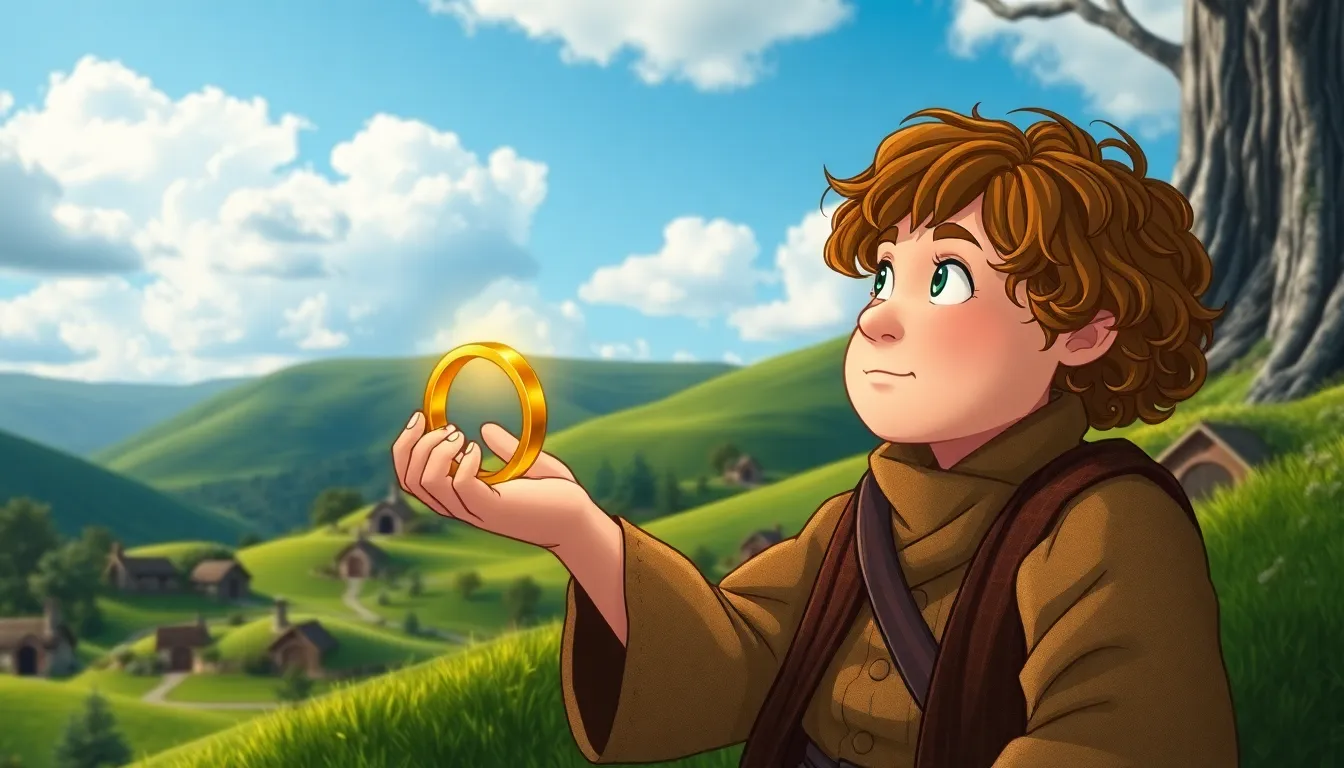In a world where dragons hoard gold and hobbits prefer second breakfasts, the enchanting tales of J.R.R. Tolkien beckon readers to embark on a remarkable journey. “The Hobbit” isn’t just a book; it’s an invitation to a fantastical adventure filled with quirky characters, unexpected friendships, and a sprinkle of mischief. But wait, before you dive into Middle-earth, it’s essential to know the order of these captivating tales to avoid any literary mishaps—like showing up to a dragon fight without a sword!
Whether you’re a seasoned adventurer or a curious newcomer, understanding the sequence of the hobbit books will enhance your experience. So grab your walking stick and a snack, and let’s explore the whimsical world of hobbits, elves, and the occasional grumpy dwarf—all while keeping it light-hearted and informative. After all, who wouldn’t want to get lost in a good book?
Table of Contents
ToggleOverview of The Hobbit Books
J.R.R. Tolkien’s “The Hobbit” serves as a cornerstone of fantasy literature. Published in 1937, it introduces readers to Bilbo Baggins, a hobbit who embarks on an unexpected adventure. This novel establishes the foundation for Tolkien’s expansive Middle-earth, blending fantastical elements with profound themes of bravery and friendship.
The sequel, “The Lord of the Rings,” extends the narrative begun in “The Hobbit.” Released in three volumes from 1954 to 1955, this epic tale follows Frodo Baggins, Bilbo’s nephew, as he seeks to destroy the One Ring. Understanding the chronological order enhances the reading experience, allowing readers to grasp the development of characters and themes.
Additionally, “The Silmarillion,” published posthumously in 1977, provides deeper insight into the mythos of Middle-earth. This collection outlines the history, creation, and mythology that precede “The Hobbit” and “The Lord of the Rings.” Readers eager to explore Tolkien’s expansive world benefit from starting with “The Hobbit,” followed by “The Lord of the Rings,” and concluding with “The Silmarillion.”
Familiarity with the order of these works enriches one’s understanding of the lore and character relationships. Readers can fully appreciate character arcs and their significance in the larger narrative. Engaging with these texts in sequence fosters a comprehensive experience of Tolkien’s artistic vision and mastery of storytelling.
The Hobbit

“The Hobbit” invites readers into a world brimming with adventure, enchantment, and unforgettable characters. Published in 1937, the novel centers around Bilbo Baggins, a hobbit who embarks on a life-changing journey.
Plot Summary
Bilbo Baggins lives a quiet life in the Shire, relishing peace and routine. His life dramatically changes when the wizard Gandalf and thirteen dwarves, led by Thorin Oakenshield, arrive at his doorstep. They persuade him to join their quest to reclaim the Lonely Mountain and its treasure from the dragon Smaug. Along the way, Bilbo encounters trolls, goblins, and giant spiders while discovering his bravery and resourcefulness. A significant moment occurs when Bilbo finds the One Ring, an object that will play a crucial role in his future. This tale embodies themes of courage, friendship, and self-discovery.
Key Themes and Characters
Courage stands out as a central theme, displayed through Bilbo’s transformation from a timid hobbit to a brave adventurer. Friendship plays a vital role, as bonds form between Bilbo and his companions, showcasing loyalty throughout their trials. Characters like Gandalf, the wise mentor, and Thorin, the conflicted leader, add depth to the story. Bilbo represents the everyman, resonating with readers who aspire to break free from comfort zones. The contrast between good and evil emerges, particularly through the characters of Smaug and the dwarves. Themes of greed and heroism illustrate the complexities of human nature within the enchanting backdrop of Middle-earth.
The Lord of the Rings Series
The Lord of the Rings series continues the magical journey initiated in The Hobbit. This trilogy explores deeper themes within the vast world of Middle-earth.
The Fellowship of the Ring
The story begins with Frodo Baggins inheriting the One Ring. Gandalf guides Frodo, encouraging him to leave the Shire for safety. Along the way, he gathers companions, including Aragorn, Legolas, and Gimli. This diverse group forms the Fellowship, meant to help Frodo on his quest. Each character contributes unique strengths, showcasing themes of friendship and bravery. The journey culminates at the Mines of Moria, where they face both external and internal struggles.
The Two Towers
The tale splits as the characters take different paths. Frodo and Sam continue toward Mount Doom, guided by Gollum, who leads them through perilous terrain. Meanwhile, Aragorn, Legolas, and Gimli pursue the captured Merry and Pippin. Their adventures reveal the growing threat of Saruman and his forces. The Battle of Helm’s Deep highlights courage in dire situations, emphasizing unity among different races. Each character’s growth profoundly shapes the narrative.
The Return of the King
Finale events escalate as the War of the Ring intensifies. Aragorn embraces his destiny as king, rallying forces against Sauron. Meanwhile, Frodo and Sam’s journey culminates in the heart of Mordor. Gollum’s betrayal and ultimate conflict bring tension and resolution. Themes of sacrifice and redemption resonate strongly throughout this volume. The series concludes with the fate of the One Ring, showcasing the power of hope and friendship against overwhelming odds.
Related Works
Exploring J.R.R. Tolkien’s expanded universe reveals various related works that deepen the understanding of Middle-earth.
The Silmarillion
Published posthumously in 1977, “The Silmarillion” presents foundational myths of Tolkien’s world. It encompasses the creation of Arda and the events leading up to “The Hobbit” and “The Lord of the Rings.” Key characters, such as Eru Ilúvatar and the Valar, play significant roles in shaping its history. The Silmarils, precious jewels crafted by Fëanor, introduce themes of ambition and despair. Throughout its stories, readers confront the struggles between good and evil, mirroring the battles faced in later works. Notably, understanding these myths enriches the context of Bilbo’s journey and the ongoing conflicts in Middle-earth.
Unfinished Tales
Released in 1980, “Unfinished Tales” compiles narratives that complement Tolkien’s primary works. These tales include detailed explorations of characters like Tuor and Galadriel, enhancing their backstories. Insights into the lore of Númenor and the origins of various races further expand the narrative framework. Additionally, earlier drafts of familiar stories provide a glimpse into Tolkien’s creative process. Readers gain deeper appreciation of themes such as fate, love, and sacrifice. Connecting these elements to “The Hobbit” and “The Lord of the Rings” illuminates the rich tapestry of Tolkien’s legendarium.
Reading The Hobbit Books in Order
Reading the hobbit books in the correct order enhances the experience of J.R.R. Tolkien’s world. Begin with “The Hobbit,” published in 1937, where readers meet Bilbo Baggins as he embarks on an unexpected adventure alongside Gandalf and thirteen dwarves. Following this tale, “The Lord of the Rings” trilogy unfolds next, consisting of three volumes: “The Fellowship of the Ring,” “The Two Towers,” and “The Return of the King.”
“The Fellowship of the Ring” introduces Frodo Baggins, who inherits the One Ring and sets out from the Shire to form a Fellowship that includes characters like Aragorn and Legolas. This journey emphasizes friendship and bravery while facing immense dangers. Next, “The Two Towers” explores the divided paths of the Fellowship as Frodo and Sam navigate the treacherous land with Gollum as their guide, while Aragorn, Legolas, and Gimli pursue rescue efforts for Merry and Pippin.
Continue with “The Return of the King,” which escalates the quest as battles rage in Middle-earth and Frodo’s determination brings him closer to Mount Doom. Each volume builds on themes of sacrifice, redemption, and unity among diverse races.
For deeper context, engage with “The Silmarillion,” published posthumously in 1977. This work outlines the extensive mythology of Middle-earth and provides crucial backstory relevant to Bilbo and Frodo’s arc. “Unfinished Tales,” released in 1980, offers additional layers with explorations of various characters and events, enriching the reader’s understanding of Tolkien’s expansive legendarium. Reading these texts in order creates a cohesive narrative experience, revealing the intricate connections woven throughout Tolkien’s storytelling.
Exploring the hobbit books in order offers readers a richer understanding of J.R.R. Tolkien’s masterful storytelling. Each book builds upon the last, weaving together themes of courage, friendship, and self-discovery. By starting with “The Hobbit” and progressing through “The Lord of the Rings,” fans can fully appreciate the character arcs and the evolving narrative.
Delving into supplementary works like “The Silmarillion” and “Unfinished Tales” further enhances the journey through Middle-earth. These texts provide essential context and background, deepening the reader’s connection to the characters and their struggles. Engaging with Tolkien’s world in the correct sequence allows for a more immersive experience, revealing the intricate layers of his legendary tales.






